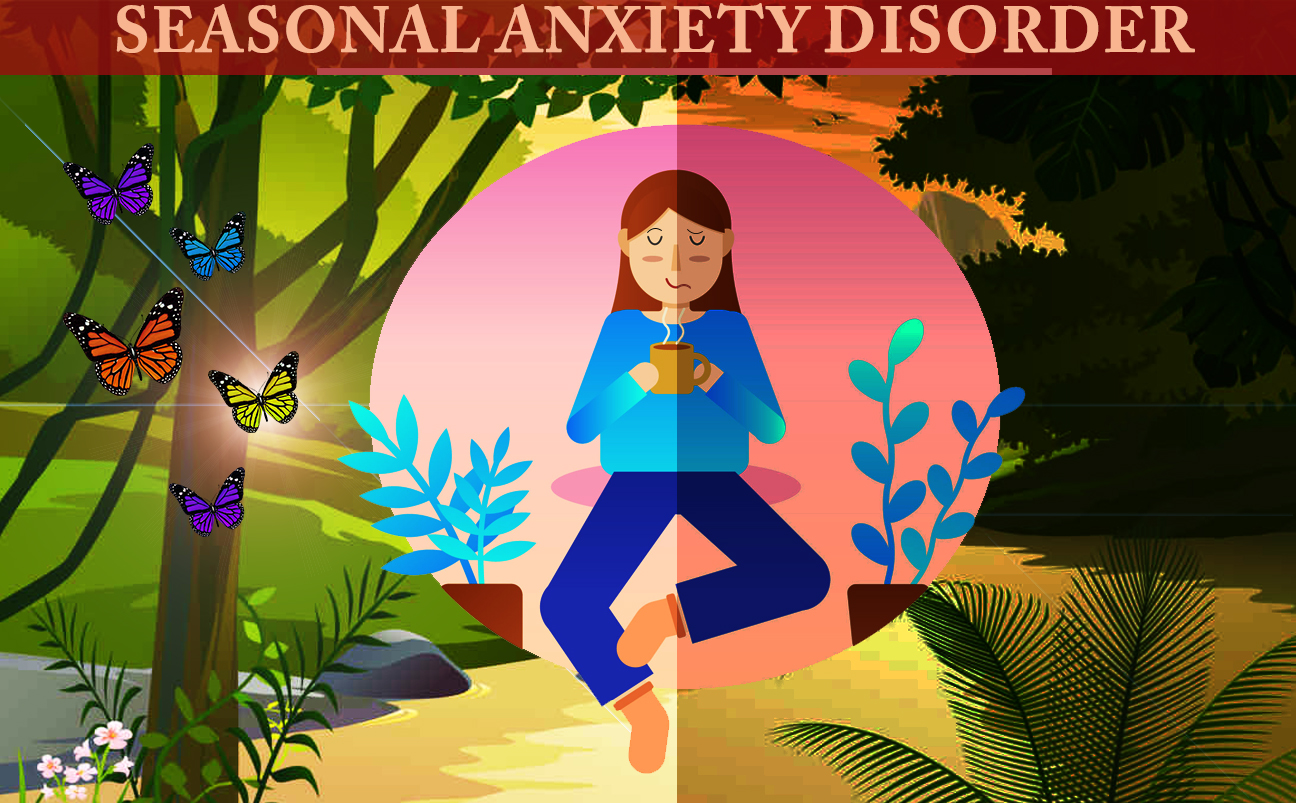Read On To Find Out All You Need To Know About Seasonal Affective Disorder
Let’s begin by understanding what it means…
There must have been short periods of time when you must have felt sad for short periods or not like your usual self. Most of the time, these mood changes begin and end during the start or end of a season.
You might have felt what is usually called “down” when the days start to get shorter during the fall and the winter. This is also called “winter blues.”
These significant mood and behavior changes are referred to as Seasonal Affective Disorder or SAD, which is a type of depression. In most of these cases, mood changes are more severe and can affect how you feel, think, and manage everyday activity.
Seasonal Affective Disorder symptoms generally start during the fall and early winter and go away during the spring and summer. This pattern is known as winter-pattern SAD or winter depression. However, there is a lesser-known pattern known as summer-pattern SAD or summer depression.
Signs & Symptoms of SAD
Experts do not consider Seasonal Affective Disorder or SAD to be a separate mental disorder. Instead, it is regarded as a type of depression characterized by a periodic seasonal pattern. The Seasonal Affective Disorder symptoms usually last for 4 to 5 months per year.

And because it is not a separate mental disorder, its symptoms are closely associated with that of major depression. However, there are specific symptoms that differ for winter-pattern and summer-pattern SAD.
Given below is a list of symptoms associated with SAD. But it is important to remember that not all people with this affliction will experience all of these symptoms.
Symptoms of Major Depression:
- A feeling of depression throughout the day, and nearly every day.
- A loss of interest in doing what you enjoyed doing.
- Loss of appetite.
- Experiencing sleeping problems.
- Feeling agitated and/or sluggish.
- Having low energy.
- A feeling of hopelessness and worthlessness.
- Having difficulty concentrating.
- Having thoughts of suicide and death.
Additional Symptoms for Winter-Pattern SAD:
- Hypersomnia or oversleeping.
- Overeating, especially a craving for foods rich in carbohydrates.
- Weight gain.
- A feeling of “hibernating” or withdrawing socially.
Symptoms for Summer-Pattern SAD:
- Insomnia or finding it difficult to fall asleep.
- A loss of appetite leading to loss of weight.
- A feeling of restlessness and agitation.
- Feeling anxious.
- Episodes of violent behavior.
Diagnosis of Seasonal Affective Disorder – How is it done?
It is essential for you to consult a mental health expert and talk to him/her about your concerns if you feel that you have Seasonal Affective Disorder.
They will probably give you specific questionnaires that you need to fill out, which will determine whether your symptoms meet the disorder’s criteria.
Following are some of the criteria that you must meet to be diagnosed with SAD:
- You should possess symptoms of severe depression or the symptoms mentioned above.
- The episodes of depression should occur during specific seasons. This means either during the summers or during the winters. Moreover, these episodes must occur for at least 2 consecutive years. But, many people do not experience the symptoms every year.
- The episodes should be more frequent than other depressive episodes that you might have had at other periods of the year in your life so far.
Causes of Seasonal Affective Disorder
To put it bluntly, scientists have not yet conclusively understood the root causes of SAD. But, research has shown that people with this disorder might have reduced activity of a brain chemical called serotonin, which is responsible for regulating our mood.
Research shows that sunlight controls the levels of molecules that help in maintaining normal levels of serotonin. However, people who suffer from Seasonal Affective Disorder are devoid of this regulation as it does not function properly. This leads to decreased levels of serotonin during winters.
Other studies show that people with SAD produce too much melatonin. This is a hormone that is essential in maintaining our normal sleep-wake cycle. The overproduction of this hormone increases sleepiness.
Both melatonin and serotonin help us maintain our body’s daily rhythm related to the seasonal day-night cycle. People with SAD, whose serotonin and melatonin levels are not appropriately regulated, faces disruption in this normal rhythm. The result of this is that they cannot adjust to the seasonal changes in day length, thus leading to changes in behavior, mood, sleep, etc.
Vitamin D deficit can worsen things even further as it promotes serotonin activity. Although we consume Vitamin D with our diet, the body also produces the vitamin when exposed to sunlight.
As daylight during winters is shorter, it is only natural that people with SAD will have lower levels of Vitamin D, which acts as a hindrance to serotonin activity.
Negative feelings and thoughts about winter and the limitations and stresses that are associated with it are widespread amongst people with this disorder. And although it is unclear whether these are causes of mood disorder, they can be used as a focus for treatment.
Risk Factors

Seasonal Anxiety Disorder is more prevalent amongst women than in men. And it affects the younger adults more than it does the older adults.
Factors that increase your risk of developing Seasonal Anxiety Disorder include the following:
- Family History:
It is highly probable that people with SAD have blood relatives with either SAD or any other form of depression.
- Having Major Depression or Even Bipolar Disorder
SAD is more common in people with severe depression and bipolar disorder. Bipolar II disorder is associated with repeated hypomanic episodes.
- Living Far Away from The Equator
Seasonal Anxiety Disorder is also more popular amongst people who live far away from the equator. This can be due to the fact that there is decreased sunlight in the winters and longer days during the summers.
Treatment of Seasonal Affective Disorder
There are mainly 4 categories of treatment of Seasonal Affective Disorder:
- Light Therapy
For almost 4 decades now, light therapy has been one of the basic forms of Seasonal Affective Disorder treatments. The aim of this treatment is to make up for the diminished natural sunshine in the winters.
In this treatment, you will be required to sit in front of a bright light box, usually 10,000 lux, every day for 30 to 45 minutes. It would be beneficial if you do this in the morning, from fall to spring.
The light boxes will be almost 20 times brighter than your regular indoor light. The box will also help filter out any harmful UV light, thus providing you with a safe environment.
It is important to remember that people with eye diseases or those who take medication that increases their sensitivity to sunlight must opt for some other form of treatment or stick with light therapy but under strict expert supervision.
- Talk Therapy or Psychotherapy
One of the most well-known of all talk therapies is Cognitive Behavioural Therapy or CBT. It focuses on assisting people by helping them to learn how to deal with difficult situations.
This therapy has also been adapted for people suffering from SAD, and it is referred to as CBT-SAD. The therapy is carried out in 2 weekly sessions over a period of 6 weeks. The main aim is to replace negative thoughts related to winter with more optimistic thoughts.
CBT-SAD makes use of a process called behavioural activation. This helps the afflicted schedule pleasant and engaging indoor and/or outdoor activities that aid them in combatting their loss of interest that they experience during the winters.
Interestingly, when researchers compared light therapy with CBT, they found that both types of therapies are equally effective in improving the symptoms. But some symptoms improved faster with light therapy. However, long-term studies show that people with SAD respond better to CBT and that the effects last longer.
- Vitamin D
Usually, people with Seasonal Affective Disorder have Vitamin D deficiency. And nutritional supplements of this vitamin can help in improving their symptoms.

Studies conducted to determine whether Vitamin D is effective in SAD treatment to have produced mixed findings. While some showed results indicating that it is as effective as light therapy, others suggested no detectable effect.
- Medications
Like other types of depression, SAD is closely associated with disturbances in our serotonin activities. For this reason, antidepressants called selective serotonin reuptake inhibitors (SSRIs) are used and considered one of the most effective Seasonal Affective Disorder treatments.
These medications are known to improve the mood, and the most commonly used ones include fluoxetine, sertraline, escitalopram, citalopram, and paroxetine.

As with all medications, these also have side effects. So it is advisable to talk to your doctor about the possible risks. You may also need to try several different antidepressants before finding out which one is actually improving your condition without any problematic side-effects.
(NOTE: All of the treatments mentioned abovecan be used alone or in combination. Consult with your expert to know which treatment or combination of treatments is best suited for you.)
Can Seasonal Anxiety Disorder be Prevented?
Owing mainly to its predictability, people who have a history of Seasonal Anxiety Disorder can start their treatments before the fall to prevent or reduce their depression.
However, to date, there have been very few studies investigating this question. And the studies that have been conducted have found no clear evidence that starting light therapy or CBT-SAD ahead of time can actually prevent the onset of the symptoms.
Hence, people with Seasonal Anxiety Disorder should discuss with their medical experts if they really want to start their treatment early in order to prevent depression.
In Conclusion
Timely treatment of Seasonal Anxiety Disorder can help you prevent further complications. This is especially true if your SAD is diagnosed and treatment is started before symptoms get worse.

